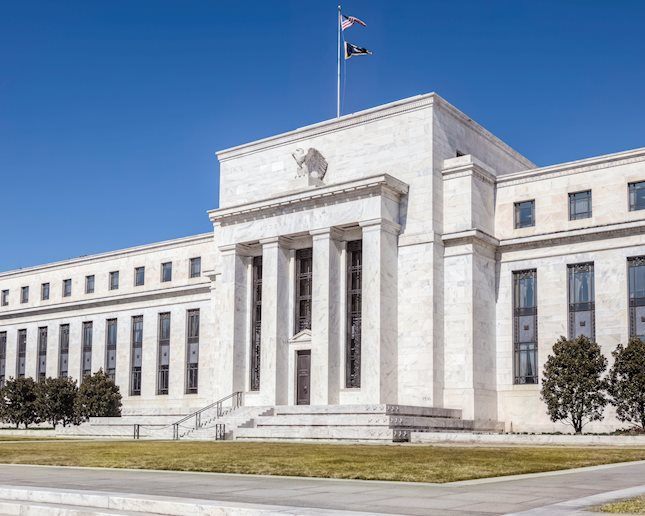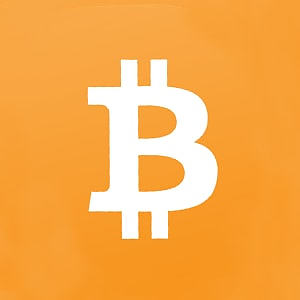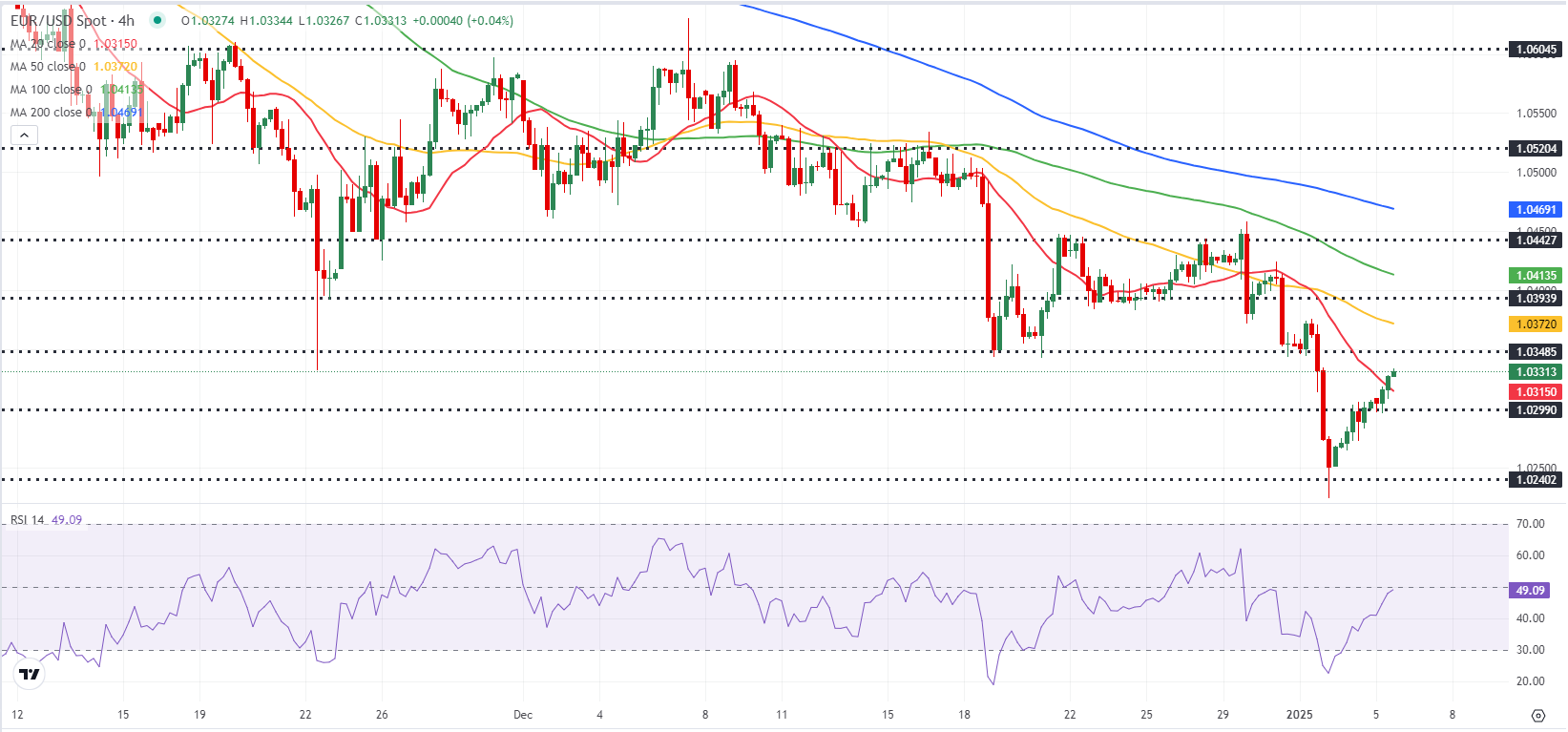- EUR/USD trades in positive territory above 1.0300 on Monday.
- Regional and nation-wide inflation data from Germany will be watched closely.
- The technical outlook points to a loss of bearish momentum in the near term.
After closing in positive territory on Friday, EUR/USD continues to edge higher and trades above 1.0300 in the European morning on Monday. Regional and nation-wide inflation data from Germany could drive the Euro's valuation later in the session.
Euro PRICE Last 7 days
The table below shows the percentage change of Euro (EUR) against listed major currencies last 7 days. Euro was the weakest against the Australian Dollar.
| USD | EUR | GBP | JPY | CAD | AUD | NZD | CHF | |
|---|---|---|---|---|---|---|---|---|
| USD | 0.90% | 0.96% | -0.03% | -0.15% | -0.22% | 0.05% | 0.67% | |
| EUR | -0.90% | 0.05% | -0.96% | -1.09% | -1.19% | -0.89% | -0.28% | |
| GBP | -0.96% | -0.05% | -1.00% | -1.14% | -1.24% | -0.95% | -0.33% | |
| JPY | 0.03% | 0.96% | 1.00% | -0.13% | -0.14% | 0.24% | 0.78% | |
| CAD | 0.15% | 1.09% | 1.14% | 0.13% | -0.08% | 0.27% | 0.82% | |
| AUD | 0.22% | 1.19% | 1.24% | 0.14% | 0.08% | 0.30% | 0.92% | |
| NZD | -0.05% | 0.89% | 0.95% | -0.24% | -0.27% | -0.30% | 0.62% | |
| CHF | -0.67% | 0.28% | 0.33% | -0.78% | -0.82% | -0.92% | -0.62% |
The heat map shows percentage changes of major currencies against each other. The base currency is picked from the left column, while the quote currency is picked from the top row. For example, if you pick the Euro from the left column and move along the horizontal line to the US Dollar, the percentage change displayed in the box will represent EUR (base)/USD (quote).
The improving risk mood heading into the weekend made it difficult for the US Dollar (USD) to find demand and helped EUR/USD erase a portion of its weekly losses on Friday.
Early Monday, US stock index futures trade marginally higher on the day, not allowing the USD to stay resilient against its rivals.
Inflation in Germany, as measured by the change in the Consumer Price Index (CPI), is forecast to rise to 2.4% on a yearly basis in December from 2.2% in November. In case the CPI rises at a stronger pace than expected, the Euro could gather strength. Investors will also pay close attention to regional CPI figures from Germany. If these data arrive generally higher than anticipated, this could be seen as a sign pointing to a positive surprise in the headline print and provide an early boost to the Euro.
On Tuesday, Eurozone inflation data and ISM Services PMI report from the US could influence EUR/USD's action.
EUR/USD Technical Analysis
The Relative Strength Index (RSI) indicator on the 4-hour chart recovered to 50, reflecting the loss of bearish momentum. Additionally, EUR/USD closed the last 4-hour candle above the 20-period Simple Moving Average (SMA).
On the upside, 1.0350 (static level), could be seen as first resistance before 1.0400-1.0410 (static level, 100-period SMA) and 1.0440 (static level). Looking south, supports could be spotted at 1.0300 (static level, round level), 1.0240 (static level) and 1.0200 (static level).
Euro FAQs
The Euro is the currency for the 19 European Union countries that belong to the Eurozone. It is the second most heavily traded currency in the world behind the US Dollar. In 2022, it accounted for 31% of all foreign exchange transactions, with an average daily turnover of over $2.2 trillion a day. EUR/USD is the most heavily traded currency pair in the world, accounting for an estimated 30% off all transactions, followed by EUR/JPY (4%), EUR/GBP (3%) and EUR/AUD (2%).
The European Central Bank (ECB) in Frankfurt, Germany, is the reserve bank for the Eurozone. The ECB sets interest rates and manages monetary policy. The ECB’s primary mandate is to maintain price stability, which means either controlling inflation or stimulating growth. Its primary tool is the raising or lowering of interest rates. Relatively high interest rates – or the expectation of higher rates – will usually benefit the Euro and vice versa. The ECB Governing Council makes monetary policy decisions at meetings held eight times a year. Decisions are made by heads of the Eurozone national banks and six permanent members, including the President of the ECB, Christine Lagarde.
Eurozone inflation data, measured by the Harmonized Index of Consumer Prices (HICP), is an important econometric for the Euro. If inflation rises more than expected, especially if above the ECB’s 2% target, it obliges the ECB to raise interest rates to bring it back under control. Relatively high interest rates compared to its counterparts will usually benefit the Euro, as it makes the region more attractive as a place for global investors to park their money.
Data releases gauge the health of the economy and can impact on the Euro. Indicators such as GDP, Manufacturing and Services PMIs, employment, and consumer sentiment surveys can all influence the direction of the single currency. A strong economy is good for the Euro. Not only does it attract more foreign investment but it may encourage the ECB to put up interest rates, which will directly strengthen the Euro. Otherwise, if economic data is weak, the Euro is likely to fall. Economic data for the four largest economies in the euro area (Germany, France, Italy and Spain) are especially significant, as they account for 75% of the Eurozone’s economy.
Another significant data release for the Euro is the Trade Balance. This indicator measures the difference between what a country earns from its exports and what it spends on imports over a given period. If a country produces highly sought after exports then its currency will gain in value purely from the extra demand created from foreign buyers seeking to purchase these goods. Therefore, a positive net Trade Balance strengthens a currency and vice versa for a negative balance.
Information on these pages contains forward-looking statements that involve risks and uncertainties. Markets and instruments profiled on this page are for informational purposes only and should not in any way come across as a recommendation to buy or sell in these assets. You should do your own thorough research before making any investment decisions. FXStreet does not in any way guarantee that this information is free from mistakes, errors, or material misstatements. It also does not guarantee that this information is of a timely nature. Investing in Open Markets involves a great deal of risk, including the loss of all or a portion of your investment, as well as emotional distress. All risks, losses and costs associated with investing, including total loss of principal, are your responsibility. The views and opinions expressed in this article are those of the authors and do not necessarily reflect the official policy or position of FXStreet nor its advertisers. The author will not be held responsible for information that is found at the end of links posted on this page.
If not otherwise explicitly mentioned in the body of the article, at the time of writing, the author has no position in any stock mentioned in this article and no business relationship with any company mentioned. The author has not received compensation for writing this article, other than from FXStreet.
FXStreet and the author do not provide personalized recommendations. The author makes no representations as to the accuracy, completeness, or suitability of this information. FXStreet and the author will not be liable for any errors, omissions or any losses, injuries or damages arising from this information and its display or use. Errors and omissions excepted.
The author and FXStreet are not registered investment advisors and nothing in this article is intended to be investment advice.
Recommended content
Editors’ Picks

EUR/USD stays around 1.0300 ahead of FOMC Minutes
EUR/USD stays under heavy selling pressure and trades around 1.0300 on Wednesday. News of US President-elect Donald Trump planning to declare an economic emergency to allow for a new tariff plan weighs on risk mood. US ADP misses expectations with 122K vs 140 anticipated.

GBP/USD drops to fresh multi-month lows, hovers around 1.2350
GBP/USD remains on the back foot and trades at its weakest level since April, around 1.2350. The risk-averse market atmosphere on growing concerns over an aggressive tariff policy by President-elect Donald Trump drags the pair lower as focus shifts to US FOMC Minutes.

Gold pressures fresh multi-week highs
Gold price (XAU/USD) advances modestly in a risk-averse environment. The benchmark 10-year US Treasury bond yield holds at its highest level since late April near 4.7%, making it difficult for XAU/USD ahead of FOMC Minutes.

Fed Minutes Preview: Key Insights on December rate cut and future policy plans
The Minutes of the Fed’s December 17-18 policy meeting will be published on Wednesday. Details surrounding the discussions on the decision to trim interest rates by 25 basis points will be scrutinized by investors.

Bitcoin edges below $96,000, wiping over leveraged traders
Bitcoin's price continues to edge lower, trading below the $96,000 level on Wednesday after declining more than 5% the previous day. The recent price decline has triggered a wave of liquidations across the crypto market, resulting in $694.11 million in total liquidations in the last 24 hours.

Best Forex Brokers with Low Spreads
VERIFIED Low spreads are crucial for reducing trading costs. Explore top Forex brokers offering competitive spreads and high leverage. Compare options for EUR/USD, GBP/USD, USD/JPY, and Gold.
